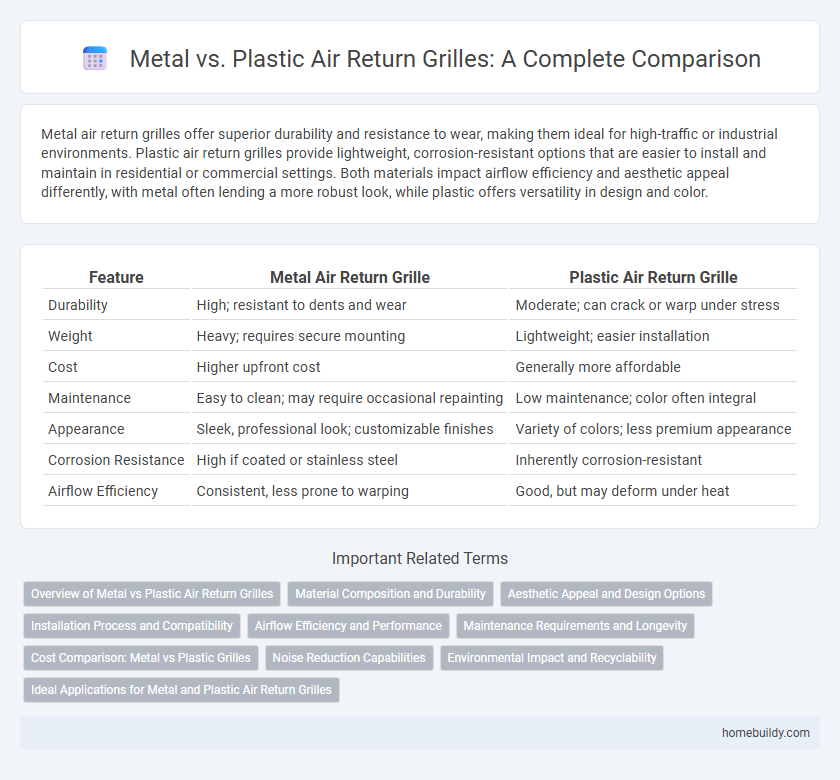Metal air return grilles offer superior durability and resistance to wear, making them ideal for high-traffic or industrial environments. Plastic air return grilles provide lightweight, corrosion-resistant options that are easier to install and maintain in residential or commercial settings. Both materials impact airflow efficiency and aesthetic appeal differently, with metal often lending a more robust look, while plastic offers versatility in design and color.
Table of Comparison
| Feature | Metal Air Return Grille | Plastic Air Return Grille |
|---|---|---|
| Durability | High; resistant to dents and wear | Moderate; can crack or warp under stress |
| Weight | Heavy; requires secure mounting | Lightweight; easier installation |
| Cost | Higher upfront cost | Generally more affordable |
| Maintenance | Easy to clean; may require occasional repainting | Low maintenance; color often integral |
| Appearance | Sleek, professional look; customizable finishes | Variety of colors; less premium appearance |
| Corrosion Resistance | High if coated or stainless steel | Inherently corrosion-resistant |
| Airflow Efficiency | Consistent, less prone to warping | Good, but may deform under heat |
Overview of Metal vs Plastic Air Return Grilles
Metal air return grilles offer superior durability, enhanced airflow efficiency, and a sleek, modern appearance compared to plastic alternatives. Plastic air return grilles provide lightweight installation and resistance to corrosion but may lack the strength and longevity needed for high-traffic or industrial environments. Choosing between metal and plastic grilles depends on factors like budget, aesthetic preference, and the specific demands of HVAC system performance.
Material Composition and Durability
Metal air return grilles are typically made from steel or aluminum, offering superior durability and resistance to wear, corrosion, and heat compared to plastic alternatives. Plastic air return grilles, commonly made from PVC or ABS, are lightweight and cost-effective but tend to degrade faster under high temperatures and mechanical stress. Metal grilles provide a longer lifespan in demanding HVAC environments, making them ideal for commercial and industrial applications.
Aesthetic Appeal and Design Options
Metal air return grilles offer a sleek, modern aesthetic with a variety of finishes such as brushed aluminum, stainless steel, and powder coating that enhance durability and visual appeal. Plastic air return grilles provide more design flexibility with customizable shapes and colors, enabling seamless integration into diverse interior styles while being lightweight and cost-effective. Both materials cater to different aesthetic priorities, where metal grilles excel in contemporary, industrial settings whereas plastic grilles suit vibrant or subtle decor themes.
Installation Process and Compatibility
Metal air return grilles typically require more precise installation techniques due to their weight and rigidity, often needing screws or anchors for secure mounting in HVAC systems. Plastic air return grilles offer greater flexibility and easier installation through snap-in or clip-on mechanisms, making them compatible with a wider range of duct sizes and wall types. Both materials must be matched carefully to the HVAC system specifications to ensure optimal airflow and prevent system inefficiencies.
Airflow Efficiency and Performance
Metal air return grilles typically offer superior airflow efficiency and durability compared to plastic grilles, as their rigid structure minimizes deformation under high air pressure, ensuring consistent performance over time. The metal material's higher thermal stability prevents warping or damage in fluctuating temperature environments, maintaining optimal airflow with less resistance. In contrast, plastic grilles may flex or crack, reducing ventilation effectiveness and requiring more frequent replacements to sustain performance standards.
Maintenance Requirements and Longevity
Metal air return grilles require minimal maintenance due to their durable, corrosion-resistant surfaces that can be easily cleaned with standard household cleaners, ensuring long-term performance without frequent replacement. Plastic air return grilles, while lightweight and resistant to rust, are more prone to cracking and discoloration over time, necessitating more frequent inspections and potential replacements. The enhanced longevity and robustness of metal grilles make them a cost-effective choice for sustained HVAC system efficiency.
Cost Comparison: Metal vs Plastic Grilles
Metal air return grilles typically cost more upfront due to raw material and manufacturing expenses, but they offer greater durability and longer lifespan, reducing replacement frequency and long-term costs. Plastic air return grilles are generally less expensive initially, making them attractive for budget-conscious projects, but they tend to wear out faster and may require more frequent replacements, increasing maintenance costs over time. Considering total cost of ownership, metal grilles often provide better value in commercial and high-traffic environments, while plastic grilles suit low-cost, low-usage applications.
Noise Reduction Capabilities
Metal air return grilles typically offer superior noise reduction capabilities compared to plastic counterparts due to their dense and rigid structure, which minimizes vibration and sound transmission. The heavyweight metal material absorbs and dampens airflow noise more effectively, contributing to quieter HVAC system operation. Plastic grilles, while lightweight and cost-effective, often allow more sound to pass through because of their thinner construction and increased flexibility.
Environmental Impact and Recyclability
Metal air return grilles offer superior recyclability compared to plastic counterparts, as metals like aluminum and steel can be recycled repeatedly without degradation, reducing landfill waste. Plastic air return grilles often contain mixed polymers that complicate recycling processes and contribute to longer decomposition times, increasing environmental impact. Choosing metal grilles supports circular economy initiatives and lowers carbon footprint through energy-efficient recycling methods.
Ideal Applications for Metal and Plastic Air Return Grilles
Metal air return grilles are ideal for industrial, commercial, and high-traffic residential applications due to their durability, resistance to wear, and superior heat tolerance. Plastic air return grilles suit light residential use where cost efficiency, flexibility, and resistance to corrosion are prioritized, especially in low-moisture areas. Selecting metal grilles in environments exposed to heavy airflow and mechanical impact enhances longevity, while plastic grilles perform best in controlled indoor climates with minimal physical stress.
metal air return grille vs plastic air return grille Infographic

 homebuildy.com
homebuildy.com